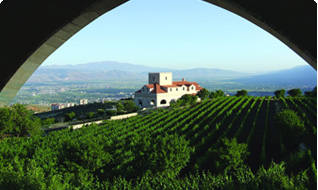
The Climat
In this region of Lebanon, the climate is continental. It’s cold and rainy in winter, and dry and very hot in the summer, with a large temperature difference between day and night (during the month of August, the temperature range is up to 20°C). In summer, the average temperature is between 25°C and 35°C. The vineyard enjoys 300 days of sunshine per year, and its location at 1,300 meters altitude ensures a fresher atmosphere than in the Bekaa Valley during the hot summer. In winter, the minimum temperature rarely drops below -5°C. From January to March, the vineyard is regularly covered by abundant snowfall.
Rainfall averages is around 600mm per year, most of which falls between mid-October and late April. The water in the basement here at our very low underground veins that are difficult to capture. Hydric stress occurs in the vineyard at just the right time – that is mid-ripening, during the month of July.
These climate characteristics have a considerable influence on the growth cycle of the vine. The slower maturation promotes increased synthesis of aroma precursors and polyphenols. These consequences are beneficial to the quality of the harvest and leave their signatures on the harmonious balance of the wine.
Our soils
The plots are very close to each other and surround the château. The vines are planted on hillsides facing south-southeast, following the slope to enjoy the morning sunshine. The most common soil is clay and limestone, which ensures retention and restitution of water regularly.
Our grapes
Our selection of grape varieties was not made by chance but instead after the advice from oenologist friends and other French experts who had been working in Lebanon for several years. The red varieties are called “noble,” and are mainly Cabernet Sauvignon, Merlot, Petit Verdot, Syrah and Cabernet Franc. One special feature was our introduction of grape varieties traditionally grown in Alsace such as the Pinot noir, Pinot Gris, Gewürztraminer and Riesling. Indeed, Château Khoury is the first winery in Lebanon to cultivate such varieties. In addition, two plots are planted with Chardonnay and Caladoc.
Our work in the vineyards
Special attention is given to the grapevine because it’s in the vineyard that the potential of a great wine is born. Careful driving performance allows the production of high quality wines.
The plantations have been made with spaced out rows of 1.8m or 2m with 1m distance between the feet and at a height of 1.3m. For pruning, the Double Guyot without bowings method is used and the vineyard is not irrigated. The yield is about 30 hl/ha, which represents less than 1.5kg of grapes per vine, thereby concentrating the flavors in the grapes.
Due to the lack of rain during the Lebanese summer, weeds are small. A single milling pass in late spring allows you to have a clean, soft ground for the rest of the year. Deep moisture is then kept at its maximum.
During the winter, the soil is ploughed twice. In July in some years, the temperature gap between day and night favors morning dew formation, making a highly virulent powdery mildew. However, using simple natural treatments with sulfur (not more than 5 per year) allows us to contain any fungus. Powdery mildew is the only threatening disease and the vineyard is free from viruses. The mildew Botrytis gray mold is absent due to the low humidity (<40%).
Today, in order to preserve the soil for future generations, the château is under organic farming, using the IMC certification warranty label.
The château’s land is the combination of natural elements that characterize the vineyard as well as the unique production methods .
